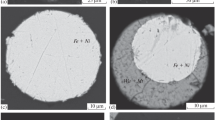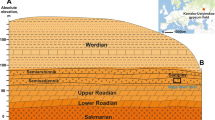Abstract
The paper reports scanning electron microscopy (FEG-SEM) and transmission electron microscopy (TEM) data on three cryptocrystalline (CC) cosmic spherules of chondritic composition (Mg/Si ≈ 1) from two collections taken up at glaciers at the Novaya Zemlya and in the area of the Tunguska event. The spherules show “brickwork” microtextures formed by minute parallel olivine crystals set in glass of pyroxene–plagioclase composition. The bulk-rock silicate chemistry, microtexture, mineralogy, and the chemical composition of the olivine and the local chemistry of the glass in these spherules testify to a chondritic source of the spherules. The solidification of the spherules in the Earth’s atmosphere was proved to be a highly unequilibrated process. A metastable state of the material follows, for example, from the occurrence of numerous nanometer-sized SiO2 globules in the interstitial glass. These globules were formed by liquid immiscibility in the pyroxene–SiO2 system. Troilite FeS and schreibersite (Fe,Ni)3P globules were found in the FeNi metal in one of the spherules, which suggests that the precursor was not chemically modified when melted in the Earth’s atmosphere. Our results allowed us to estimate the mineralogy of the precursor material and correlate the CC spherules with the chondrule material of chondrites. The bulk compositions of the spherules are closely similar to those of type-IIA chondrules.
Similar content being viewed by others
References
N. S. Andreev, O. V. Mazurin, E. A. Porai-Koshits, G. P. Roslova, and V. N. Filippovich, Liquid Immiscibility in Glasses, (Nauka, Leningrad, 1974) [in Russian].
D. D. Badjukov and J. Raitala, “Micrometeorites from the northern ice cap of the Novaya Zemlya archipelago, Russia: the first occurrence,” Meteorit. Planet. Sci. 38, 329–340 (2003).
D. D. Badjukov, F. Brandstätter, J. Raitala, and G. Kurat, “Basaltic micrometeorites from the Novaya Zemlya glacier,” Meteorit. Planet. Sci. 45 (9), 1502–1512 (2010).
D. D. Badjukov, A. V. Ivanov, J. Raitala, and N. R. Khisina, “Spherules from the Tunguska event site: could they originate from the Tunguska cosmic body?” Geochem. Int. 49 (7), 641–653 (2011).
A. J. Berry and H. St. O’Neill, “A XANES determination of the oxidation state of chromium in silicate glasses,” Am. Mineral. 89, 790–798 (2004)
M. B. Blanchard, D. E. Brownlee, T. E. Bunch, P. W. Hodge, and F. T. Kyte, “Meteoroid ablation spheres from deep sea sediments,” Earth Planet. Sci. Lett. 46, 178–190 (1980).
D. E. Brownlee, B. A. Bates, and R. H. Beauchamps, “Meteor ablation spherules as chondrule analogs,” in Chondrules and their Origin, Ed. by E. A. King (Lunar and Planetary Institute, Houston, 1984), pp. 10–25.
D. E. Brownlee, B. Bates, and L. Schram, “The elemental composition of stony cosmic spherules,” Meteorit. Planet. Sci. 32, 157–175 (1997).
D. E. Brownlee, L. B. Pilachowski, and P. W. Hodge, “Meteorite mining in the ocean floor,” Lunar Planet. Sci. Conf. 10, 109–111 (1979).
C.-H. Chen and D. C. Presnall, “The system Mg2SiO4–SiO2 at pressures up to 25 kilobars,” Am. Mineral. 60, 398–406 (1975).
R. N. Clayton, T. K. Mayeda, and D. E. Brownlee, “Oxygen isotopes in deep-sea spherules,” Earth Planet. Sci. Lett. 79, 235–240 (1986).
C. Cordier, L. Folco, C. Suavet, C. Sonzogni, and P. Rochette, “Major, trace element and oxygen isotope study of glass cosmic spherules of chondrite composition: the record of their source material and atmospheric entry heating,” Geochim. Cosmochim. Acta 75, 5203–5218 (2011).
J. A. Dalton and D. C. Presnall “No liquid immiscibility in the system MgSiO3–SiO2 at 5.0 GPa,” Geochim. Cosmochim. Acta 61 (12), 2367–2373 (1997).
C. Engrand, K. D. McKegan, L. A. Leshin, and D. E. Brownlee, “In-situ measurement of oxygen isotopic compositions of deep-sea and Antarctic cosmic spherules,” Lunar Planet. Sci. Conf. 29, abstract #1473 (1998).
F. Ya. Galakhov, “Microliquid immiscibility and its image in the two-phase diagram,” Izv. Akad. Nauk, Ser. Khim., No. 8, 1377–1383 (1964).
M. J. Genge and M. M. Grady, “Melted micrometeorites from Antarctic ice with evidence for the separation of immiscible Fe–Ni–S liquids during entry heating,” Meteorit. Planet. Sci. 33, 425–439 (1998).
T. Gondo and H. Isobe, “Artificial cosmic spherules produced by melting experiments of the powdered Allende meteorite,” Lunar Planet. Sci. Conf. 44, abstract #1882 (2013).
R. H. Hewins, B. Zanda, and C. Bendersky, “Evaporation and recondensation of sodium in Semarcona Type II chondrules,” Geochim. Cosmochim. Acta 78, 1–17 (2012).
R. H. Jones, “Petrology and mineralogy of type-II, FeOrich chondrules in Semarkona (LL3.0)—origin by closedsystem fractional crystallization, with evidence for supercooling,” Geochim. Cosmochim. Acta 54, 1785–1802 (1990).
S. A. Kirillova, V. I. Al’myashev, and V. V. Gusarov, “Spinodal breakdown in the SiO2–TiO2 system and formation of hierarchically arranged nanostructures,” Nanosyst.: Fiz., Khim., Mathem. 3 (2), 100–115 (2012).
R. J. Kirkpatrick, B. H. Reck, I. Z.Pelly, and Lung-Chuan Kuo, “Programmed cooling experiments in the system MgO–SiO2: kinetics of a peritectic reaction,” Am. Mineral. 68, 1095–1101 (1983).
G. Kurat, C. Koeberl, T. Presper, F. Brandstatter, and M. Maurette, “Petrology and geochemistry of Antarctic micrometeorites,” Geochim. Cosmochim. Acta 58, 3879–3904 (1994).
D. S. Laurette, H. Nagahara, and C. M. O’ D. Alexander, “Petrology and origin of ferromagnesian silicate chondrules,” in Meteorites and the Early Solar System II, Ed. by D. S. Laurette and H. Y. McSween (Univ. of Arizona Press, 2006), pp. 431–459.
S. G. Love and D. E. Brownlee, “Heating and thermal transformation of micrometeoroids entering the Earth’s atmosphere,” Icarus 89, 26–43 (1991).
S. G. Love and D. E. Brownlee “A direct measurement of the terrestrial mass accretion rate of cosmic dust,” Science 262, 550–553 (1993).
M. Maurette, C. Olinger, M. C. Mishel-Levy, G. Kurat, M. Pourchet, F. Brandstatter, and M. Bourot-Denise, “A collection of diverse micrometeorites recovered from 100 tonns of Antarctic blue ice,” Nature 351, 44–46 (1991).
H. D. Palme, C. Hezel, and D. S. Ebel, “The origin of chondrules: constraints from matrix composition and matrix–chondrule complementarity,” Earth Planet. Sci. Lett. 411, 11–19 (2015).
K. M. Parashar, S. Prasad, and S. S. Chauhan. “Investigation on a large collection of cosmic dust from the central Indian Ocean,” Earth Moon Planets 107, 197–217 (2010).
P. Rochette, L. Folco, C. Suavet, M. van Ginneken, J. Gattacceca, N. Perchiazzi, R. Braucher, and R. P. Harvey, “Micrometeorites from the Transantarctic Mountains,” PNAS 105, 18206–18211 (2008).
Taylor S. and Brownlee, D. E. “Cosmic spherules in the geologic record,” Meteoritics 26, 203–211 (1991).
S. Taylor, C. M. O. Alexander, J. S. Delaney, P. Ma, G. F. Herzog, and C. Engrand, “Isotopic fractionation of iron, potassium, and oxygen in stony cosmic spherules: implications for heating histories and sources,” Geochim. Cosmochim. Acta 69, 2647–2662 (2005).
S. Taylor, J. H. Lever, and R. P. Harvey, “Numbers, types, and compositions of an unbiased collection of cosmic spherules,” Meteorit. Planet. Sci. 35, 651–666 (2000).
I. V. Veksler, A. M. Dorfman, D. Rhede, R. Wirth, A. A. Borisov, and D. B. Dingwell, “Liquid unmixing kinetics and the extent of immiscibility in the system K2O–CaO–FeO–Al2O3–SiO2,” J. Geol. 256, 119–130 (2008).
T. Yada and H. Kojima, “The collection of micrometeorites collected in the Yamato Meteorite Ice Field of Antarctica in 1998,” Antarct. Meteorit. Res. 13, 9–18 (2000).
T. Yada, T. Nakamura, T. Noguchi, N. Matsumoto, M. Kusakabe, H. Hiyagon, T. Ushikubo, N. Sugiura, H. Kojima, and N. Takaoka, “Oxygen isotopic and chemical compositions of cosmic spherules collected from the Antarctic ice sheet: implications for their precursor material,” Geochim. Cosmochim. Acta 69, 5789–5804 (2005).
Author information
Authors and Affiliations
Corresponding author
Additional information
Original Russian Text © N.R. Khisina, D.D. Badyukov, R. Wirth, 2016, published in Geokhimiya, 2016, No. 1, pp. 78–88.
Rights and permissions
About this article
Cite this article
Khisina, N.R., Badyukov, D.D. & Wirth, R. Microtexture, nanomineralogy, and local chemistry of cryptocrystalline cosmic spherules. Geochem. Int. 54, 68–77 (2016). https://doi.org/10.1134/S0016702916010067
Received:
Accepted:
Published:
Issue Date:
DOI: https://doi.org/10.1134/S0016702916010067




